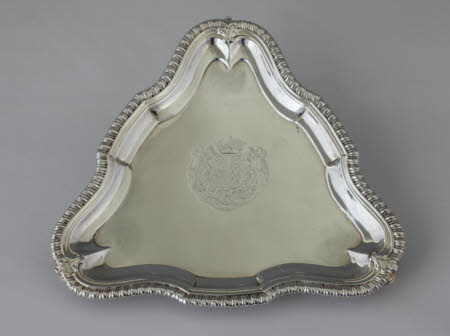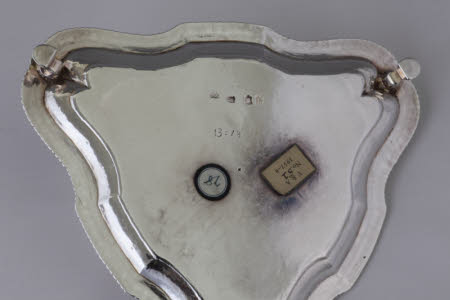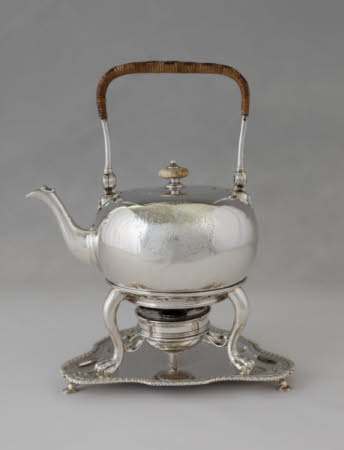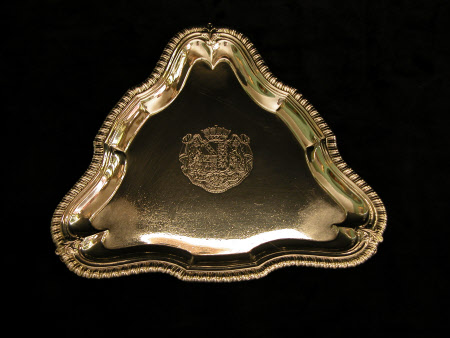Kettle waiter
Frederick Kandler
Category
Silver
Date
1745 - 1746
Materials
Sterling silver
Measurements
1.9 x 22.9 x 22.4 cm
Place of origin
London
Order this imageCollection
Ickworth, Suffolk
NT 852071.4
Summary
Kettle waiter, sterling silver, Frederick Kandler, London, 1745-6. Shaped triangular waiter with incurved corners, raised with a cast gadroon border enriched by leaves at the terminal points of the triangle, with three cast hoof feet. Heraldry: The centre of the waiter is engraved with the quartered shield, supporters and motto of the 2nd Earl of Bristol in an ermine mantling and beneath an earl’s coronet.
Full description
This waiter, which is associated with the kettle and lamp by Pierre Le Cheaube (NT 852071.1-3), was probably part of the large order given to Frederick Kandler by the 2nd Earl of Bristol in 1751. Although the piece was made in 1745 the arms do not seem to have been re-engraved and they must date from the Earl’s accession six years later. Triangular waiters for kettles became fashionable in the 1730s, with large numbers appearing in the early ledgers of George Wickes.[1] They were perfectly suited to the three-legged kettle stands of the period and the shaped gadroon border of this one conformed to the dishes and plates of the Earl’s dinner service. Waiters were often provided for vessels associated with hot water, presumably with the practical intention of containing drips and reducing the risk of overturning. The borders are usually deeper than those intended to be used by a footman to serve, as when delivering wine glasses to the table during dinner (see NT 852097). The survival of some pairs and groups of triangle waiters suggests that they were not just employed for kettles. Three from the fine silver of the Lords King, two by John White of 1734 and a third by Robert Abercromby of 1740, have elaborate flat-chased borders which cannot have been intended to be interrupted by the feet of a lamp frame.[2] James Rothwell, Decorative Arts Curator January 2021 [Adapted from James Rothwell, Silver for Entertaining: The Ickworth Collection, London 2017, cat. 25, p. 103] Notes: [1] National Art Library, Garrard Ledgers, VAM 1–3 1735–50. [2] Christie’s, 12 May 1993, lots 148-9. Another pair, by Richard Rugg, 1754, was sold at Sotheby’s Olympia, 6 June 2002, lot 129.
Provenance
Probably acquiried by the 2nd Earl of Bristol (1721-75); by descent to the 4th Marquess of Bristol (1863-1951); accepted by the Treasury in lieu of death duties in 1956 and transferred to the National Trust.
Credit line
Ickworth, the Bristol Collection (National Trust)
Marks and inscriptions
Underside: Hallmarks: Fully marked on the underside with maker’s mark ‘FK’ in italics beneath a fleur-de-lis (Arthur Grimwade, London Goldsmiths 1697-1837, 1990, no. 691), lion passant, leopard’s head and date letter ‘k’. Underside: Scratchweight: ‘13=18’ Underside: Round label, blue lines '28'; rectangular label ‘V & A No. 52 1957-8’.
Makers and roles
Frederick Kandler, goldsmith previously catalogued as by Paul Crespin and Frederick Kandler (d.1778), goldsmith
References
James Rothwell, Silver for Entertaining: The Ickworth Collection. Philip Wilson Publishers, 2016, cat. 25



